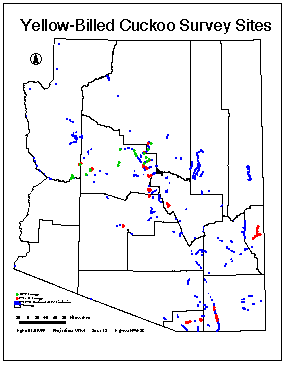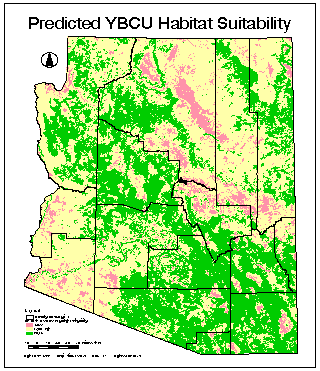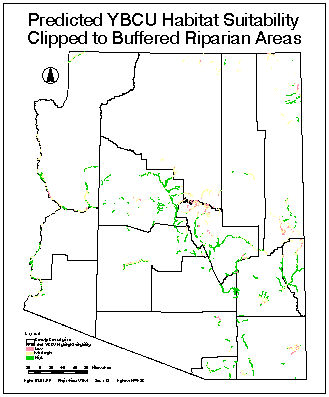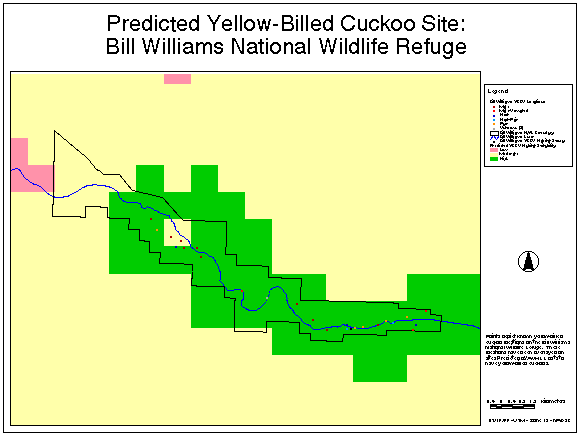
The western yellow-billed cuckoo, Coccyzus americanus occidentalis, typically nests in mature riparian forests and woodlands along central and southern Arizona drainages and locally along the Virgin river. Riparian habitat alteration from vegetation clearing, stream diversion, water management, agriculture, urbanization, overgrazing, and recreation have caused reductions in the breeding range of the yellow-billed cuckoo over the last 60 years (Laymon and Halterman 1987). As a result, western yellow-billed cuckoos have been petitioned for possible listing under the Endangered Species Act (1973 as amended). To facilitate current species censusing and monitoring activities, a GIS and concomitant correlation models are relied upon to delineate potential yellow-billed cuckoo habitat and to help determine cost effective field data collection strategies. Initially, GIS and modeling efforts were constrained to legacy data sets such as existing layers of environmental data and historic breeding locations of western yellow-billed cuckoos in Arizona. Eventually, these course scaled methods for identifying potential locations of yellow-billed cuckoo breeding habitats will be refined to include higher resolution spatial data and a wider array of secondary database attributes required to succinctly define habitat requirements.
Introduction
Historically, the western yellow-billed cuckoo occupied and bred in riparian zones from southern British Columbia to northern Mexico, including the states of Oregon, Washington, southwestern Idaho, California, Nevada, Utah, western Colorado, Arizona, New Mexico, and western Texas. Current evidence suggests that western yellow-billed cuckoo breeding is now restricted to California, Arizona, New Mexico, Utah, extreme western Texas, Sonora, Chihuahua, and south irregularly to Zacatecas, Mexico (Howell and Webb 1995, Russell and Monson 1998). The largest breeding populations of the Western yellow-billed cuckoo (Coccyzus americanus occidentalis) in the United States may now be confined to New Mexico and southeastern Arizona. Population estimates of the yellow-billed cuckoo include; less than 50 pairs in California (Halterman 1991); an estimated 902 pairs in the middle Rio Grande and the Pecos rivers in New Mexico (Howe 1986); and an estimated 846 pairs along the major rivers of southern Arizona (Groschupf 1987). The exact distribution and habitat requirements of the western yellow-billed cuckoo in Arizona are not known. Preliminary surveys in 1998 were conducted in areas where the species was historically noted. The yellow-billed cuckoo has been associated with cottonwood-willow dominated broadleaf deciduous riparian habitat (Hamilton and Hamilton 1965, Gaines 1974, Gaines and Laymon 1984, Laymon and Halterman 1986a, Halterman 1991). The purpose of this one year preliminary project was to revisit historic locations for site fidelity by confirming the presence and absence of yellow-billed cuckoo records, to collect and better delineate vegetation characteristics in presumably predictable yellow-billed cuckoo habitat, and to utilize AVHRR remote-sensing satellite imagery processing techniques to predict potential bird habitat.
Yellow-billed Cuckoo Survey Techniques



Preliminary GIS Analysis

AVHRR images are acquired daily, as opposed to the bi-weekly revisit cycle of many other sensors. AVHRR data are often used in research on land-cover change since the frequency of data availability permits the detection of short-lived vegetation and landscape changes that may be missed by other sensors. A derived image reflecting vegetation photosynthetic activity, the Normalized Difference Vegetation Index (NDVI) is calculated as a maximum value composite for every 2-week period to produce a cloud free image. The NDVI is calculated from the reflectance values of the visible and near-infrared regions of the electromagnetic spectrum and is sensitive to various biophysical vegetation characteristics, such as biomass and percent cover (Price 1992, Huete and Jackson 1987). (Visit the Arizona Regional Information Archive (ARIA) to view a movie of the 26 2-week NDVI composites of Arizona during 1998, http://aria.arizona.edu). The movie shows areas of abundant vegetation in bright green and areas of little or no vegetation in red. The loop starts in January and ends in December, showing the timing and progression of vegetation green-up across the state. We applied various mathematical techniques (described below) to extract measures describing the temporal dynamics of the NDVI signal at each pixel.
The GIS software packages utilized for this type of analysis were Environmental Systems Research Institute (Esri) ArcView 3.1 and Arc Info 7.1.2. Image processing was accomplished in Erdas Imagine 8.3.1. Data preprocessing of the original data and the creation of the fourier-derived matrices were accomplished using MathWorks Matlab 5.2. Additional data processing was conducted using Microsoft Excel 97. Statistical analyses were performed in the Statistical Product and Service Solutions (SPSS) 8.0 software package. Results were exported to Excel for the creation of representative graphs. Using these tools, we performed the following:
Amount of greenness:
| sets A vs. D | Sets C vs. D | sets A vs. B | ||||
|
|
|
|
|
|
|
|
| AZ98_TSAVE |
|
|
|
|
|
|
| AZ98_TSSDE |
|
|
|
|
||
| AZ98_COV |
|
|
|
|
||
| AZ98_DC |
|
|
|
|
|
|
| AZ98_MAG |
|
|
|
|
||
| AZ98_JULIAN |
|
|
|
|
||
| AZ98_PC1 |
|
|
|
|
|
|
| AZ98_PC2 |
|
|
|
|
||
| AZ98_PC3 |
|
|
||||
| ++ = Significant at the 0.05 level, + = significant at the 0.10 level | ||||||
|
Preference
|
AZ98_TSAVE
|
AZ98_TSSD
|
AZ98_COV
|
AZ98_MAG
|
AZ98_PROD
|
AZ98_JULIAN
|
AZ98_PC3
|
AZ98_PC1
|
|
Low
|
1
|
0
|
0
|
0
|
1
|
0
|
1
|
2
|
|
Medium
|
13
|
20
|
13
|
9
|
10
|
15
|
6
|
34
|
|
High
|
25
|
19
|
26
|
30
|
28
|
24
|
32
|
3
|
|
Total Birds
|
39
|
39
|
39
|
39
|
39
|
39
|
39
|
39
|



A number of factors influencing the number of birds counted in a sampling unit (mapping plots, polygons, transects or parts of transects, unequal temporal and spatial resolution sampling factors, inherent habitat variability, weather factors, and a wide array of human errors), may introduce a large amount of error. Consequently, using simple presence/absence bird counts and polygons delineated by a combination of historical factors and local experts as inputs for a yellow-billed cuckoo distribution and habitat model may lack precision if not accuracy. Unfortunately with limited time and funding, statistical extrapolation is a necessity if not a requirement for intelligent decision making by land managers and conservation experts. Models are valuable tools but all population estimates based on extrapolations should be carefully interpreted (Dawson 1981).
Bibby, C.J., N.D. Burgess and D.A. Hill. 1992. Bird census techniques. Academic Press. New York, NY. 257 pp.
Dawson, D.G. 1981. Experimental design when counting birds. Studies in Avian Biology No. 6:392-398.
Eastman, J.R. and M. Fulk (1993) Long Sequence Time Series Evaluation Using Standardized Principal Components. Photogrammetric Engineering and Remote Sensing. 59(6):991-996.
EDC (1994) Conterminous United States AVHRR Data on CD ROM - User's Manual, U.S. Department of Interior, Eros Data Center, Souix Falls, SD.
Eidenshink, J. C. (1992) The 1990 Conterminous U.S. AVHRR Data Set. Photogrammetric Engineering and Remote Sensing. 58:809-813.
Franzreb K., and Laymon, S.A. 1993. A reassessment of the taxonomic status of the yellow-billed cuckoo. Western birds 24:17-28
Franzreb, K. 1987. Perspectives on managing riparian ecosystems for endangered bird species. Western birds 18:10-13.
Gaines D.A. and S.A. Laymon. 1984. Decline status and preservation of the yellow-billed cuckoo in California. Western Birds 15:49-80.
Gaines, D. 1974. Review of the status of the yellow-billed cuckoo in California: Sacramento Valley Populations. Condor 76:204-209.
Groschupf, K. 1987. Status of the yellow-billed cuckoo (Coccyzus americanus occidentalis) in Arizona and New Mexico. Contract No. 20181-86-00731.
Halterman M. 1991. Distribution and habitat use of the yellow-billed cuckoo (Coccyzus americanus occidentalis) on the Sacramento River, California, 1987-1990. MS Thesis, California State University, Chico.
Hamilton W.J. and M.E. Hamilton. 1965. Breeding characteristics of yellow-billed cuckoos in Arizona. Pages 405-432 in Proceedings of the California Academy of Sciences. Fourth Series.
Hirosawa, Y., S.E. Marsh and D.H. Kliman (1996) Application of Standardized Principal Component Analysis to Land-Cover Characterization Using Multitemporal AVHRR Data. Remote Sensing of Environment. 58:267-281.
Howe, W.H. 1986. Status of the yellow-billed cuckoo (Coccyzus americanus) in new Mexico. Final Report to New Mexico Department of Game and Fish. Share with wildlife.
Howell, S.N.G. and S. Webb. 1995. A guide to the birds of Mexico and northern Central America. Oxford University Press, New York.
Huete, A.R., and Jackson, R.D. (1987) Suitability of Spectral Indices for Evaluating Vegetation Characteristics on Arid Rangelands. Remote Sensing of Environment. 23:213-232.
Johnson, R.R., B.T. Brown, L.T. Haight and J.M. Simpson. 1981. Playback recordings as a special avian censusing technique. Pages 68-75 in C.J. Ralph and J.M. Scott [eds.], Estimating numbers of terrestrial birds. Studies in avian biology. Allen Press, Inc. Lawrence KS.
Laymon, S. A. 1998. yellow-billed cuckoo survey and monitoring protocol for California. Unpublished.
Laymon, S.A. and M.D. Halterman. 1987. Can the western subspecies of the yellow-billed cuckoo be saved from extinction. Western birds 18:19-25.
Laymon, S.A. and M.D. Halterman.. 1986a. Part1. 1986 Survey of yellow-billed cuckoos in southern California. 24 pp.
Laymon, S.A. and M.D. Halterman.. 1986b. Part II. Nesting ecology of the yellow-billed cuckoo on the Kern River: 1986. 30 pp.
Nolan, V. Jr. and C.F. Thompson. 1975. The occurrence and significance of anomalous reproductive activities in two North American non-parasitic cuckoos Coccyzus spp. Ibis 117:496-503.
Phillips, A., J. Marshall and G. Marshall. 1964. The birds of Arizona. University of Arizona Press, Tucson. 220 pp.
Price, J.C. (1992) Estimating Vegetation Amount from Visible and Near Infrared Reflectances. Remote Sensing of Environment. 41:29-34.
Rosenberg K.V., R.D. Ohmart, W.C. Hunter, B.W. Anderson. 1991. Birds of the lower Colorado Valley. University of Arizona Press, Tucson. 416 pp.
Russell, S.M., G. Monson. 1998. The birds of Sonora. University of Arizona Press. Tucson. pp 360.
Warren, P. L., K. L. Reichardt, D. A. Mouat, B. T. Brown, and R. R. Johnson. 1982. Vegetation of Grand Canyon National Park. Tucson, Ariz.: USDI, Nat. Park Serv., CPSU/UA.